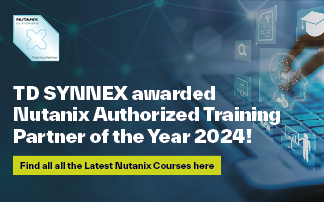Advanced Administration and Performance Management (AAPM) 6.5
(EDU-C-AAPM65-NTC)
Flex Credits accepted : 51 Credits per seat
- Wenn Sie ein erfahrener Nutanix-Administrator sind, wird Ihnen dieser Kurs ein tiefgehendes Verständnis der Nutanix-Plattform vermitteln und Ihnen helfen, das Beste aus Ihren Nutanix-Lösungen herauszuholen. AAPM ist in sechs große Abschnitte unterteilt, die sich jeweils auf Leistungsverbesserungen und fortgeschrittene Verwaltungstechniken für verschiedene Aspekte Ihrer Cluster konzentrieren:
- Storage: Tauchen Sie ein in die AOS-Storage-Services, verschiedene Aspekte von Acropolis Distributed Storage, Storage-Optimierung und Best Practices für Anwendungs-Workloads.
- Networks: Erfahren Sie, wie Sie physische und virtuelle Workloads optimieren und wie Sie Flow Virtual Networking und Virtual Private Clouds (VPCs) implementieren können.
- VMs: Erfahren Sie mehr über die Dimensionierung von CVM und Prism Central VMs, alternative Methoden der VM-Bereitstellung (z. B. über CLI), die Arbeit mit GPUs und die Verbesserung der VM-Speicher- und Netzwerkleistung.
- Security: Verstehen Sie wichtige Funktionen wie Authentifizierung, RBAC, IAM und Verschlüsselung. Lernen Sie, wie Sie wichtige Sicherheitsprodukte wie Flow Security Central und Flow Network Security verwenden.
- Analyzing Problems: Entdecken Sie Möglichkeiten zur Überwachung und Identifizierung von Gesundheitsproblemen, Netzwerkleistung, VM-Leistung und Clusterleistung.
- Business Continuity and Disaster Recovery: Erfahren Sie mehr über Nutanix-Datensicherung, Datensicherung im Web, Schutz vor Ransomware, Self-Service-Wiederherstellung und Integration von Drittanbietern. Außerdem lernen Sie, wie Sie Schutzdomänen und Nutanix Leap für die Notfallwiederherstellung nutzen können.
Prüfung
- Die Prüfung ist jeweils im Kurspreis bereits enthalten und erfolgt separat online außerhalb des Trainings. Die Freischaltung der Teilnehmer für das Online-Portal erfolgt durch Nutanix.
Kursinhalt
- Exploring Nutanix Storage Features
- Creating a Highly Available, Performant, and Resilient Storage Layer
- Optimizing Physical and Virtual Networks in AOS
- Optimizing Overlay Networks Using Flow Networking
- Optimizing VM Performance
- Analyzing Nutanix Cluster Security Options
- Microsegmentation with Flow Network Security
- Microsegmentation with Flow Network Security
- Business Continuity
- Implementing Disaster Recovery
Zielgruppe
- Dieser Kurs richtet sich an Administratoren, Architekten und Führungskräfte, die bereits Nutanix-Cluster in einem Rechenzentrum verwalten, aber Ihre Kenntnisse in Bezug auf die Nutanix Datacenter-Administration erweitern möchten.
Voraussetzungen
- Besuch des Nutanix Enterprise Cloud Administration 6.5 oder Zertifizierung des NCP-MCI
- Grundkenntnisse von Nutanix Datacenter-Administrationstechniken
- Vertraut mit Virtualization-Storage-Architekturen
- Erfahren im Umgang mit Linux Command Line-Interfaces
Kursziel
- Dieser Kurs dient zur Vorbereitung der Zertifizierung des Nutanix Certified Master - Multicloud Infrastructure (NCM-MCI).
Content
1: Exploring Nutanix Storage Features
- Understanding Nutanix AOS Services and AOS Storage Services
- Exploring Storage Components
- AOS Storage Data Pathing
Hands-on Labs
- Creating a Storage Container
- Updating Reported Capacity
2: Creating a Highly Available, Performant, and Resilient Storage Layer
- Creating Highly Available, Resilient Infrastructure
- Storage Optimization and Data Efficiency
- Optimizing and Planning for New Workloads
- Storage Best Practices for Application Workloads
Hands-on Labs
- Observing Nutanix Cloning Efficiency
- Reserving Rebuild Capacity in AHV
- Observing the Rebuild Process
- Disabling Rebuild Capacity Reservation
- Creating a Storage Container with Deduplication Enabled
- Reviewing Deduplication Savings
- Enabling Replication Factor 1 and Creating a Storage Container
3: Optimizing Physical and Virtual Networks in AOS
- Optimizing Physical & Virtual Networks
- Best Practices
Hands-on Labs
- Managing Virtual Switches and Uplinks
- Viewing Virtual Switches from Prism Element
- Configuring CVM Network Segmentation
- Configuring QoS Traffic Marking
4: Optimizing Overlay Networks Using Flow Networking
- Optimizing Physical & Virtual Networks
- Implementing Flow Networking
- Implementing VPCs
- Overlay Network Use Cases
Hands-on Labs
- Enabling Flow Networking
- Creating an External Subnet
- Creating a VPC
- Creating VMs using the Overlay Subnets
- Configuring Local and Remote Gateways
- Establishing a VPN Connection
- Verifying VPN Connectivity
5: Optimizing VM Performance
- Sizing the CVM & Prism Central
- Alternate Methods of Provisioning User VMs
- Working with GPUs in AHV
- Improving VM Storage and Network Performance
Hands-on Labs
- Creating VMs with the REST API
- Configuring VirtIO Multi-Queue
- Configuring Volumes Block Storage
6: Analyzing Nutanix Cluster Security Options
- Nutanix Security Technologies
- User Authentication and Permissions
- Hardening AHV and the CVM
- Using Flow Network Security & Flow Security Central
- Data Encryption with Nutanix
- Managing Log Files
Hands-on Labs
- Configuring Cluster Lockdown
- Replacing Default SSL Certificates
- Configuring Syslog Integration
- Managing User Permissions
7: Microsegmentation with Flow Network Security
- Flow Policy Constructs
- Security Policy Models and Types
- Enabling Microsegmentation
- Creating and Applying Policies
Hands-on Labs
- Enabling Flow Microsegmentation
- Creating Categories
- Creating VMs and Assigning Categories
- Configuring Isolation and Application Security Policies
8: Microsegmentation with Flow Network Security
- Evaluating Cluster Health
- Network Packet Capture and Inspection
- Acropolis Service Failures
- Ensuring Efficient Physical Resource Consumption with Machine Learning
- Application Monitoring and Discovery
- Monitoring Performance
Hands-on Labs
- Creating a Prism Central Performance Monitoring Dashboard
- Creating Charts to Analyze Metrics Using Prism Central
- Creating Charts to Analyze Entities Using Prism Element
9: Business Continuity
- Assessing Business Continuity and Disaster Recovery
- High Availability and Data Protection
- Third Party Backup Integrations
- Best Practices
Hands-on Labs
- Configuring Self Service Restore
10: Implementing Disaster Recovery
- Replicating Data with AOS
- Disaster Recovery Orchestration
- Disaster Recovery with Protection Domains
- Getting Started with Nutanix Leap
- Protecting Against Ransomware
Hands-on Labs
- Enabling Nutanix Leap
- Configuring an Availability Zone
- Configuring a Protection Policy
- Creating Production and Test VLANs
- Preparing VMs for Nutanix Leap
- Configuring a Recovery Plan
- Performing Test and Planned Failover







